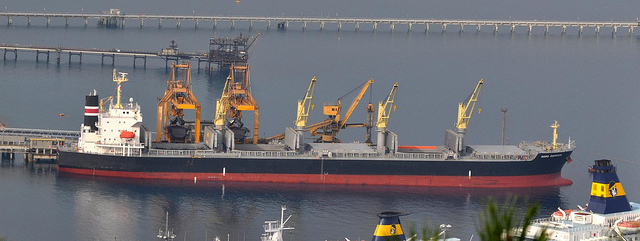Merchant ships names are prefixed by which kind of vessel they are:
- MV = Motor Vessel
- SS = Steam Ship
- MT = Motor Tanker or Motor Tug Boat
- MSV = Motor Stand-by Vessel
- MY = Motor Yacht
- RMS = Royal Mail Ship
- RRS = Royal Research Ship
- SV = Sailing Vessel (although these can be sub coded as type of sailing vessel)
- LPG = Gas carrier transporting liquefied petroleum gas
- LNG = Gas carrier transporting liquefied natural gas
- CS = Cable Ship or Cable layer.
Merchant Ship Categories....
Until vessels started to be built to carry specific cargoes, all vessels were simply general or dry cargo vessels, i.e. built to carry any and all cargoes either in drums and bales or on pallets. Such cargoes were put in general holds with no specialization. The role of the general/dry cargo vessel began to wane with the arrival of bulk-carriers and tankers, but the decline of these general vessels has accelerated since the arrival of containerization (in the 1960's). Not only are container ships able to carry greater volumes of cargo in standard shaped cargo containers, the time spent loading and discharging has been dramatically reduced. Whereas a dry cargo vessel may take 3 - 4 days to load or discharge, a container ship can achieve the same in a matter of hours. Although general/ dry cargo vessels remain as the largest (in pure numbers) of cargo carrying vessels, they are often smaller (rarely above 50,000 Gross tons) than the specialized vessels that are slowly replacing them.
Bulkcarriers ("bulkers"), are the great work horses of the shipping world, carrying raw dry cargoes in huge cavernous holds, such as coal, iron ore, grain, sulphur, scrap metal. Until recently, there had been a huge demand for these vessels, driven by the extraordinary expansion of the Chinese economy. Imports of iron ore into China boosted the earnings of bulk carrier owners as freight rates went through the roof into uncharted territory. For a 'Capesize' bulkcarrier, daily hire rates of over $280,000 per day were recorded. Then came the downturn in late 2008 and freight rates have slumped, with bulkcarriers struggling to be fixed above $20,000 ! - quite a dramatic change in only a few months. Unfortunately, huge numbers of these vessels were ordered from shipyards during the 'boom' times. Taking about 2 years to build, many of these new ships will be delivered only to be sent probably straight to lay-up, as no work can be found for them.
There are two types of bulkcarriers , one is that rare beast called a "Geared" bulkcarrier, because it carries it's own cargo cranes and another one is a more regular design of "Gearless" bulkcarrier.
Geared bulkcarriers Gearless bulkcarriers

| Bulkers range from about 25,000 DWT ("handysize") through the medium size ("Panamax")vessels of about 75,000 DWT, to the giant ("capsize") vessels of up to 200,000 DWT (Some go bigger than that even !). Demand for the large "Capesize" bulkcarriers has never been higher, and there are a few "subdivisions" within this "Capesize" type, such as "Kamsarmax" (being the largest vessels able to enter the port of Kamsar, Equatorial Guinea, at about 175,000 DWT), "Newastlemax" (being the largest to be able to enter the port of Newcastle, Australia at about 185,000 DWT) and "Setouchmax" (being the largest able to navigate the Setouch Sea, Japan at about 203,000 DWT). With such high demand outstipping supply, some Very Large Crude Carriers are being converted to Very Large Ore Carriers (VLOC) and this is now a new size type for bulkcarriers over 200,000 DWT. Due to the heavy use that these vessels are put to, their life-expectancy is less than it would be for say, a container ship. |
|
|
|
|
A Tanker is a ship designed to transport liquid in bulk. Major types of tankers include the Oil tanker, the Chemical Tanker, and Gas carrier.
Oil Tanker
Chemical Tanker
LNG Carrier
An oil tanker, also known as a petroleum tanker, is a merchant shipdesigned for the bulk transport of oil. There are two basic types of oil tankers: the crude tanker and the product tanker. Crude tankers move large quantities of unrefined crude oil from its point of extraction to refineries. Product tankers, generally much smaller, are designed to move petrochemicals from refineries to points near consuming markets.
|
Tankers are designed to carry liquid cargoes (not just oil) although the carriage of crude oil has brought the tanker unwelcome attention and largely unjustified criticism. Oil tankers come in two basic flavours, the crude carrier, which carries crude oil, and the clean products tanker, which carries the refined products, such as petrol, gasolene, aviation fuel, kerosene and paraffin. Tankers range in all sizes, from the small bunkering tanker (used for refuelling larger vessels) of 1000 DWT tons to the real giants: the VLCC (Very Large Crude Carrier) of between 2-300,000 DWT and the ULCC (Ultra Large Crude Carrier) of over 300,000 DWT.
Types of tankers:
- Handysize Tanker: 20,000-30,000 DWT.
- Handymax Tanker : Approx. 45,000 DWT.
- Panamax Tanker: Approx. 79,000 DWT.
- Aframax Tanker: Between 79,000-1,20,000 DWT.
- Suezmax Tanker: Between 1,20,000-1,80,000 DWT.
- V.L.C.C. Tanker: Between 2,00,000-3,00,000 DWT.
- U.L.C.C. Tanker: Over 3,00,000 DWT.
It should be remembered that over 60% of the world's oil is transported by these tankers, and over 99% of that arrives safely without causing pollution. Indeed most oil pollution seen on beaches comes from the engine rooms of vessels (of all types) and not from the cargo tanks of tankers.
|
|







No comments:
Post a Comment